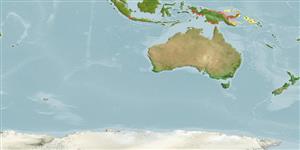Environment: milieu / climate zone / depth range / distribution range
بوم شناسي
دريايي; آب شيرين; لب شور; غير مهاجر. Tropical; 2°S - 10°S
Southwest Pacific: known from several sites but probably extends from Toro Pass near the mouth of the Fly River (Papua New Guinea) to Vogelkop Peninsula, Irian Jaya, and from Woods Inlet in Darwin Harbor, Australia.
Size / Weight / سن
Maturity: Lm ? range ? - ? cm
Max length : 3.5 cm TL جنس نر / بدون خواص جنسي; (Ref. 9786)
توصيف مختصر
ريخت شناسي | ريخت ستجي بوسيله انداره گيري
خارهاي باله پشتي (کل): 3 - 4; شعاع نرم باله پشتي (کل): 5-6; خارهاي باله مخرجي 1; شعاع نرم باله مخرجي: 10 - 12. Predorsal scale count 14 to 17. Sexual dimorphism not apparent in this species.
Found in mangrove swamps and saline creeks (Ref. 9786, 44894). Occurs infringing coastal mangroves in brackish or marine waters. Aggregations shelter among submerged roots or inundated leaves and branches (Ref. 44894). This is a planktivorous species which adapts well to freshwater environment. May occur in large schools, frequently in muddy waters. Sympatric with P. cyanodorsalis over part of its range (Ref. 9786). Probably more widespread, but has escaped notice due to its small size and largely inaccessible habitat (Ref. 44894).
Life cycle and mating behavior
بلوغ | تولید مثل | تخم ریزی | تخم ها | Fecundity | توزاد ( لارو)
Ivantsoff, W., 1999. Order Atheriniformes. Pseudomugilidae. Blue eyes. p. 2109-2112. In K.E. Carpenter and V.H. Niem (eds.) FAO species identification guide for fishery purposes. The living marine resources of the Western Central Pacific. Volume 4. Bony fishes part 2 (Mugilidae to Carangidae). FAO, Rome. (Ref. 9786)
وضعيت در فهرست قرمز IUCN (Ref. 130435)
خطر برای انسان ها
Harmless
استفاده انسانی
ماهي گيري – شيلات: از بی علاقه گی
اطلاعات بيشتر
اسامي عاممترادفسوخت و سازشکارچیانسم شناسي بوم زيستيتولید مثلبلوغتخم ریزیSpawning aggregationFecundityتخم هانمو تخم
Age/Sizeرشدطول - وزنطول - طولنوسانات طولیريخت ستجي بوسيله انداره گيريريخت شناسيتوزاد ( لارو)پويايي لارويبازسازیفراوانيBRUVS
مراجعآبزي پرورينمايه آبزي پرورينژادهاژنتيكElectrophoresesوارثبيماري هافرآوریNutrientsMass conversion
همكارانعکس هاStamps, Coins Misc.صداهاسيگواتراسرعتنوع شناگریمنطقه آبششيOtolithsمغزهابینایی
ابزارها
گزارش های ويژه
بارگيری XML
منابع اينترنتي
Estimates based on models
Preferred temperature (Ref.
123201): 27.9 - 29.1, mean 28.7 °C (based on 249 cells).
Phylogenetic diversity index (Ref.
82804): PD
50 = 0.5000 [Uniqueness, from 0.5 = low to 2.0 = high].
Bayesian length-weight: a=0.00389 (0.00180 - 0.00842), b=3.12 (2.94 - 3.30), in cm total length, based on all LWR estimates for this body shape (Ref.
93245).
Trophic level (Ref.
69278): 3.4 ±0.45 se; based on food items.
Fishing Vulnerability (Ref.
59153): Low vulnerability (10 of 100).
